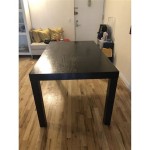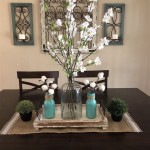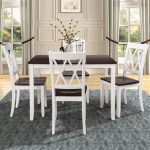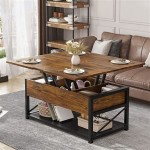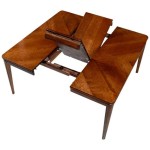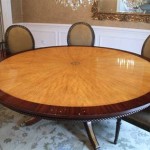Ideas for Painting Dining Table and Chairs: A Comprehensive Guide
Painting a dining table and chairs can revitalize a tired set, transforming it from a dated piece into a focal point that complements the overall aesthetic of a dining space. This project offers an opportunity to personalize furniture, coordinate with existing décor, and achieve a high-end look without the cost of purchasing new items. The success of this endeavor hinges on careful planning, proper preparation, and the selection of appropriate painting techniques and materials.
Before embarking on this project, it is essential to assess the existing condition of the dining table and chairs. Factors such as the type of wood, the presence of existing finishes, and any structural damage will influence the approach chosen. Furniture made from solid wood offers greater versatility, allowing for sanding and refinishing. Veneered furniture requires a more delicate approach to avoid damaging the thin layer of wood veneer. Any structural damage, such as loose joints or broken legs, should be addressed before commencing the painting process. This article explores various painting ideas, preparation techniques, and finishing options to ensure a durable and visually appealing result.
Choosing the Right Paint and Materials
The selection of paint is critical for achieving a professional and long-lasting finish. Different paint types offer varying degrees of durability, sheen, and ease of application. Consider the intended use of the dining table and chairs, the desired aesthetic, and the existing finish of the furniture when making this decision. Several commonly used paints are suitable for furniture painting, each with its own advantages and disadvantages.
Latex paint is a popular choice due to its water-based formulation, low odor, and ease of cleanup. It offers excellent durability and is available in a wide range of colors and sheens. However, latex paint may require multiple coats to achieve full coverage, and it may not adhere as well to certain surfaces without proper priming. Acrylic paint is another water-based option that offers similar benefits to latex paint, with slightly improved adhesion and durability. Acrylic paint is often formulated to be self-priming, streamlining the painting process. However, it is essential to select an acrylic paint specifically designed for furniture to ensure optimal performance.
Oil-based paint, while less common due to its higher VOC content and longer drying time, offers exceptional durability and a smooth, even finish. Oil-based paint is more resistant to scratches, chips, and stains than water-based paints, making it a suitable choice for high-use furniture. However, it requires mineral spirits for cleanup, and the fumes can be strong. Chalk paint is a specialized paint that provides a matte finish and excellent adhesion to a variety of surfaces. It requires minimal surface preparation, making it a convenient option for DIY projects. Chalk paint can be easily distressed for a vintage or antique look. However, it typically requires a protective topcoat of wax or sealant to enhance its durability and prevent staining.
Beyond paint, other essential materials include sandpaper (various grits), primer, paintbrushes (both synthetic and natural bristles, depending on the paint type), paint rollers (foam or microfiber), painter's tape, drop cloths, cleaning supplies (such as TSP or denatured alcohol), and protective eyewear and gloves. Primer is crucial for ensuring proper adhesion of the paint, particularly on glossy or non-porous surfaces. It also helps to create a uniform surface for the paint, resulting in a smoother finish.
The choice of finish or topcoat is just as important as the paint itself. It protects the paint from scratches, stains, and wear and tear, extending the life of the painted furniture. Polyurethane is a durable and versatile topcoat option that provides a clear, protective layer. It is available in both water-based and oil-based formulations, with varying degrees of sheen. Wax is another popular option for protecting chalk-painted furniture. It provides a soft, velvety finish and enhances the distressed look. However, wax requires periodic reapplication to maintain its protective properties.
Preparation is Key: Ensuring a Lasting Finish
Proper preparation is paramount for achieving a professional-looking and durable painted finish. This involves cleaning, sanding, and priming the furniture before applying any paint. Thorough cleaning removes dirt, grease, and grime that can interfere with paint adhesion. A solution of TSP (trisodium phosphate) or denatured alcohol can be used to clean the furniture thoroughly. Always follow the manufacturer's instructions when using cleaning chemicals and wear appropriate protective gear.
Sanding is essential for creating a smooth, even surface for the paint to adhere to. The grit of sandpaper to use will depend on the existing condition of the furniture. Start with a coarser grit (e.g., 80-120) to remove any existing imperfections, such as scratches or dents. Then, gradually move to finer grits (e.g., 220-320) to smooth the surface. Sand in the direction of the wood grain whenever possible. For veneered furniture, use a very fine grit sandpaper and avoid sanding too aggressively, as this can damage the veneer.
After sanding, thoroughly remove all sanding dust with a tack cloth or a damp cloth. Dust can interfere with paint adhesion and create a rough texture. Applying a primer is crucial for ensuring proper adhesion of the paint, especially on glossy or non-porous surfaces. Primer also helps to create a uniform surface for the paint, resulting in a smoother finish. Choose a primer that is compatible with the type of paint being used. Apply the primer in thin, even coats, following the manufacturer's instructions. Allow the primer to dry completely before proceeding to the painting stage.
For intricate details or hard-to-reach areas, use painter's tape to mask off any surfaces that are not to be painted. This will help to create crisp, clean lines and prevent paint from bleeding onto unwanted areas. Ensure the painter's tape is applied firmly and smoothly to prevent paint from seeping underneath. Consider disassembling the furniture, if possible, before painting. This will allow for easier access to all surfaces and prevent paint from getting onto the hardware.
In situations where the existing finish is excessively thick or heavily damaged, consider using a paint stripper to remove it completely before sanding. Paint strippers can be messy and require careful handling, but they can significantly improve the final result. Always follow the manufacturer's instructions when using paint strippers and wear appropriate protective gear.
Painting Techniques and Design Ideas
The application of paint is a crucial step in achieving a professional-looking finish. Use high-quality brushes and rollers designed for the type of paint being used. Apply the paint in thin, even coats, avoiding drips and runs. Multiple thin coats are preferable to one thick coat, as they will dry more evenly and prevent the paint from cracking or peeling. Allow each coat to dry completely before applying the next.
For a smooth, even finish, use a paint roller for large, flat surfaces and a paintbrush for details and edges. Use a "laying off" technique to minimize brushstrokes. This involves gently smoothing the paint in the direction of the wood grain after applying it with a brush. When using a paint roller, apply the paint in a "W" pattern and then fill in the gaps. This will ensure even coverage and prevent roller marks.
Experiment with different painting techniques to create unique and interesting effects. Distressing involves intentionally removing some of the paint to reveal the underlying wood or layers of paint. This technique is often used to create a vintage or antique look. Use sandpaper, steel wool, or a scraper to remove the paint in strategic areas, such as edges and corners. Consider applying a glaze or antiquing wax to enhance the distressed effect.
Ombre painting involves gradually blending two or more colors together. This technique can be used to create a subtle and sophisticated effect. Start by painting the furniture with the base color. Then, gradually add the second color, blending it into the base color as you go. Use a damp sponge or brush to blend the colors together seamlessly. Stenciling can be used to add decorative patterns or designs to the furniture. Use stencils and paintbrushes to apply the paint in the desired pattern. Ensure the stencil is securely attached to the furniture to prevent paint from bleeding underneath.
Consider incorporating design elements that complement the existing décor of the dining space. For a modern look, use bold, contrasting colors and clean lines. For a traditional look, use muted colors and classic patterns. For a rustic look, use natural colors and distressed finishes. Upholstering the dining chairs can add comfort and style. Choose fabrics that complement the painted finish of the table and chairs. Consider adding decorative details, such as nailhead trim or tufting.
When selecting colors, consider the size and lighting of the dining space. Lighter colors can make a small space feel larger and brighter. Darker colors can create a cozy and intimate atmosphere. Test paint colors in the space before making a final decision. Paint small samples of the colors on a piece of cardboard and observe them in different lighting conditions. Take photographs of the samples and compare them to the existing décor.
Ultimately, painting a dining table and chairs offers a myriad of creative possibilities. By choosing the right materials, preparing the furniture properly, and employing appropriate painting techniques, it is possible to transform an ordinary piece into a stunning focal point that enhances the overall aesthetic of the dining space.

180 Painted Dining Set Ideas Decor Furniture

How To Paint A Vintage Dining Table Bluesky At Home

7 Paint Ideas To Transform A Dining Table Eatwell101

Painted Dining Room Set

Dining Table Makeover Take One Confessions Of A Serial Do It Yourselfer

Dining Room Table Makeover Sew Crafty Crochet

How To Paint Dining Chairs Get Professional Results The Homes I Have Made

How To Save Tired Dining Room Chairs With Chalk Paint Right Now

How To Paint A Vintage Dining Table Bluesky At Home

How To Recover A Dining Room Chair


